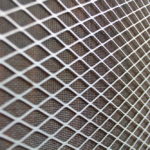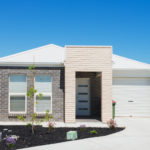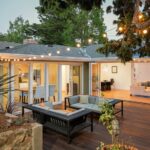The front door is the most likely point of entry for any home break-in. That means this needs to be the strongest part of your home security. There are many ways to increase the security of your front door, some of which are almost imperceptible. Other protections are costly and may affect the look and feel of the home. With such a wide range of options, there is no excuse to leave your home exposed, and there is no reason to spend a fortune making improvements. If you are renting, make sure to speak with your landlord before making any changes, no matter how small you think they are.
- Longer Screws
One of the simplest and most noninvasive ways to improve the security of your front door is to use longer screws to fasten your door hinges and strike plates. Most standard locks are installed with screws that are an inch, or maybe even an inch and a half, in length. This bites into the wood enough for alignment and functionality purposes, but it does not offer much security.
With just a three-inch screw, you are securing the strike and hinges to the wall stud. A screw that is biting into a stud will stand up to a significant amount of force beyond a simple set screw. This helps to prevent against kicking attacks on both the hinge and doorjamb sides of the door.
- Use the Right Lock
A front door should always use at least one deadbolt in addition to a keyed knob or handle. The deadbolt is immune to the widely known credit card method of surreptitious entry. When the bolt is thrown, it is not retractable without a key or a thumbturn on the interior of the door. This is different from the spring latch in a keyed doorknob, which can be depressed even while in the locked position.
If there is any glass on or around the door, it is very important to use a double-sided deadbolt. These deadbolts do not have a thumbturn, and require the use of a key when locking and unlocking from both inside and outside the home. Even if a criminal were to smash the glass near a double-sided deadbolt, they could not gain entry any easier. High-security locks are also necessary to prevent against more advanced forms of illegal entry, such as lock picking and bump keys. Make sure that lock installation is done correctly or the security of the lock will be diminished. In lieu of installing new locks, homeowners can also rekey locks (if they already have a deadbolt in place) to maximize their home security.
- Add Metal
In order to install a door lock, several holes must be cut into the wood of the door. These holes are not completely filled by metal, and therefore leave vulnerable areas, which a susceptible to violent entry attacks. This means the area of your door that holds the lock hardware is actually a weak point in the door. By placing metal sleeves around that area, these points cannot be as easily compromised.
The same is true for the doorjamb, which will almost always have a simple small metal strike plate to hold the latch and/or bolt of your locks. By having this strike plate be longer, and secured throughout the length of the jamb, the door is secured against forced entry. Some of these products are hidden by the closed door, so these measures do not need to change the look of your home.
- Better Door Composition
If you secure your hinges, hardware, and the doorjamb, then there is still the concern of the door itself breaking. All doors are not created equal. For exterior doors, and especially front doors, you need a product with a solid core. These doors are heavier, as they use more material and stronger wood in their construction.
For additional security, there are steel core doors, and even iron core doors, which add metal content to the door itself. The addition of a new door would be the most costly and visually dramatic change proposed so far, but it is a must if the wrong type of door has already been installed.
- Security Screens
A security screen changes the look of your home from the exterior, but it provides a vast range of protection. Firstly, it will have more locks installed, which is an obstacle for anyone trying to bump or pick the locks. There is also another door, which is made out of metal, so forced entry is going to take at least twice as long as it would with just a standard door.
Residents can also open their door to see who is outside, without exposing themselves to a threat. And opposed to traditional woven screen doors, there is still a layer of security if you would like to leave your front door open for some fresh air.
Tips for Renters:
If you are renting, it is not so simple to make changes to the home. Often you will need to suggest your ideas to the landlord, who will then make the final decision. So it is important that you have been acting in compliance with what your landlord wants. Try not to be difficult or demanding. You are trying to present a solution, not a problem. So find a solution that works for your needs, and that you believe your landlord would be open to. For example, you may know that they do not like changes that alter the look of the home. So you would not suggest overly visible changes such as a security screen or new door.
Come to them with a full proposal. If you force them to come up with their own answers, the process will be much slower. The less work you make for them, the better chances of a quick and positive response. Who you want to pay for the changes will also affect your success. If you are looking to pass the cost onto the landlord, the offer to only charge the cost of materials will be more appealing than including the cost of labor. Try to anticipate their issues, and appeal to them on matters they care about. For example, even attempted burglary would result in many replacement costs as well as insurance issues, and general repairs. Be personable, and try to be positive.








